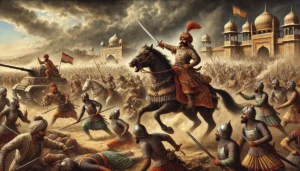Table of Contents
First Anglo-Sikh War (1845–46)
Causes of the War
- British Policy of Annexation
The British had long coveted Punjab, especially after the death of Ranjit Singh. While they did not manage to annex Punjab directly during his reign, they pursued strategies to keep it under control. In 1836, they successfully persuaded Ranjit Singh to withdraw from Sindh, and by 1835, they captured Ferozepur. The British also sought to block Ranjit Singh’s westward expansion through the Tripartite Treaty of 1838, which was designed to prevent further growth of the Punjab Empire. - Weak Administration after Ranjit Singh’s Death
After Ranjit Singh’s death in 1839, Punjab descended into political turmoil, creating an opportunity for British intervention. The absence of a strong central authority in Punjab made it easier for the British to prepare militarily. They reinforced their military presence on the Satluj front, signaling their intentions. - British Failure in the First Afghan War (1839-42)
The British defeat in Afghanistan undermined their image of military invincibility. They sought to restore their reputation by expanding their control in the region, with Punjab being a strategic target. In 1843, the British also annexed Sindh, a move that further heightened tensions with Punjab. - Geographical Familiarity with Punjab
The British were familiar with Punjab’s geography due to their military campaigns, especially during the First Afghan War, where they passed through the region with the help of Sher Singh. This familiarity helped the British plan an effective offensive strategy. - Role of Rani Jindan Kaur
Rani Jindan Kaur, the mother of the young Maharaja Dalip Singh, rallied the Sikh army against the British. The failure of the British Army in Afghanistan gave Sikhs a sense of hope, as they no longer viewed the British as invincible. - Appointment of Lord Hardinge as Governor-General
In 1844, the British appointed Lord Hardinge as the new Governor-General. His military background and appointment raised suspicions in Punjab that he was brought in specifically to annex the region. - Betrayal of Sikh Leaders
Sikh leaders Lal Singh and Tej Singh, who were in key positions of power, secretly conspired with the British to undermine the Sikh forces. Fearing the power of the Sikh army, they sought to weaken it from within by collaborating with the British. - Violation of the Treaty of Amritsar
The British needed a justification to go to war. Lal Singh, as part of the conspiracy, ordered the Sikh army to cross the Satluj River, violating the Treaty of Amritsar (1809). This provided the British with a reason to declare war, as the Sikhs had technically initiated hostilities.
Main Events of the War
- Battle of Mudki (December 18, 1845)
- Fought between: Sikh forces under Lal Singh and British forces led by Sir Hugh Gough
- Outcome: British victory, but Sikh forces inflicted heavy casualties before Lal Singh betrayed the troops by fleeing the battlefield.
- Battle of Ferozeshah (December 21, 1845)
- Fought between: Sikh forces under Lal Singh and Tej Singh, and British forces led by Sir Hugh Gough
- Outcome: The Sikhs initially overwhelmed the British, but the betrayal of their leaders turned the tide in favor of the British. The British captured the Sikh entrenchments on December 22, 1845.
- Battle of Baddowal (January 21, 1846)
- Fought between: Sikh forces under Ranjodh Singh Majithia and British forces led by Henry Smith
- Outcome: Sikh forces won, with the British suffering heavy losses. This victory temporarily boosted Sikh morale.
- Battle of Aliwal (January 28, 1846)
- Fought between: Sikh forces under Ranjodh Singh Majithia and British forces led by Sir Henry Smith
- Outcome: British victory. The Sikh forces were forced to retreat across the Satluj River.
- Battle of Sabraon (February 10, 1846)
- Fought between: Sikh forces under Lal Singh, Tej Singh, and Sham Singh Atariwala, and British forces led by Sir Hugh Gough and Lord Hardinge
- Outcome: British victory. Despite brave efforts by Sikh soldiers, including the sacrifice of Sham Singh Atariwala, the Sikh forces were defeated, leading to the British capturing Lahore on February 20, 1846.
Battles of the First Anglo-Sikh War
| S. No. | Battle | Fought Between | Outcome | Date |
| 1 | Battle of Mudki | Lal Singh vs. Sir Hugh Gough | British Victory | December 18, 1845 |
| 2 | Battle of Ferozeshah | Lal Singh and Tej Singh vs. Sir Hugh Gough | British Victory | December 21, 1845 |
| 3 | Battle of Baddowal | Ranjodh Singh Majithia vs. Henry Smith | Sikh Victory | January 21, 1846 |
| 4 | Battle of Aliwal | Ranjodh Singh Majithia vs. Sir Henry Smith | British Victory | January 28, 1846 |
| 5 | Battle of Sabraon | Lal Singh, Tej Singh, Sham Singh Atariwala vs. Sir Hugh Gough and Lord Hardinge | British Victory | February 10, 1846 |
Treaty of Lahore (March 9, 1846)
Following the British victory, a treaty was signed between the British and Maharaja Dalip Singh, formally ending the conflict. The terms of the Treaty of Lahore were as follows:
- Cession of Territory: Maharaja Dalip Singh renounced any claims to territories south of the River Satluj.
- Surrender of Forts and Rights: The Sikh Kingdom ceded all forts, territories, and rights in the Bist Doab region.
- Indemnity: The Lahore Durbar could not pay the required indemnity of one and a half crores of rupees, so they ceded Kashmir and other territories to the British in return for one crore. The remaining 50 lakh rupees were paid by the Maharaja.
- Limitation of the Sikh Army: The Sikh army was restricted to 25 battalions of infantry and 12,000 cavalry. All Sikh artillery captured at Sabraon was handed over to the British.
- Passage Rights: The British were granted free passage through the Lahore territories and the right to prevent any foreign engagement without British consent.
- Maharaja Dalip Singh’s Position: Dalip Singh remained the nominal Maharaja, with Rani Jindan acting as Regent, and Lal Singh as the Prime Minister.
- Non-Interference Clause: The British promised not to interfere in the internal affairs of the Sikh Kingdom but maintained a large military presence in Lahore for protection until the end of 1846.
Note: The treaty also arranged the transfer of Kashmir to Gulab Singh of Jammu in exchange for one crore rupees, marking the beginning of Jammu and Kashmir’s integration into the British sphere.
Significance of the Treaty
- Territorial Changes: While Punjab was not formally annexed by the British, they gained significant territorial control, including Kashmir, the Bist Doab, and territories south of the Satluj River.
- Military Weakening of Punjab: The treaty crippled the Sikh military by limiting its size and surrendering essential artillery, weakening the power of the Lahore Durbar.
- Economic Consequences: The large indemnity placed a heavy financial burden on the Sikh Kingdom, making it economically unstable.
The First Anglo-Sikh War thus marked a pivotal moment in the British expansion in India, setting the stage for the eventual annexation of Punjab in 1849 after the Second Anglo-Sikh War.
Why Did the British Not Annex Punjab in 1846?
Despite defeating the Sikh forces in the First Anglo-Sikh War, the British chose not to annex Punjab immediately due to the following reasons:
| Reason | Explanation |
| Resistance from Sikh Soldiers | After the battles of Mudki, Ferozeshah, and Sabraon, several Sikh soldiers remained stationed in cities like Lahore, Amritsar, and Peshawar. The British would have had to fight these forces, which was not feasible as they had already exhausted their resources. |
| Economic Burden | The cost of maintaining law and order in Punjab was projected to exceed the revenue generated, making annexation financially impractical for the British. |
| Strategic Buffer | The Sikh Kingdom served as a buffer state between British India and Afghanistan, reducing the risk of invasions from the northwest. |
Thus, Lord Hardinge opted for an alliance with the Sikhs that weakened the kingdom, allowing him to annex Punjab at a later, more favorable time.
The Second Anglo-Sikh War (1848-1849)
Causes of the war
- Sikh Resentment and Overconfidence: Following their defeat in the First Anglo-Sikh War, many Sikh leaders believed that they lost due to betrayal rather than inherent weakness. They felt that they could easily defeat the British in a second attempt. Additionally, the Lahore government was forced to pay an annual tribute to the British, which led to discontent among Sikh soldiers whose wages were cut to meet the cost.
- Social Reforms: British social reforms introduced by Henry Lawrence, such as changes in the military structure and governance, angered the Sikh population, further fueling anti-British sentiment.
- Mistreatment of Maharani Jindan Kaur: The British banished Maharani Jindan Kaur, wife of Maharaja Ranjit Singh, and reduced her pension, inflaming Sikh hostility toward the British.
- Lord Dalhousie’s Ambitions: As the Governor-General from 1848, Lord Dalhousie sought to expand British control and planned the annexation of Punjab. His appointment of Frederick Currie as the British Resident in Lahore further escalated tensions.
- The Revolt of Multan: The immediate spark for the Second Anglo-Sikh War was the revolt in Multan. Diwan Mulraj, after a dispute with the British, declared war against them. This gave the British a pretext to launch a full-scale military campaign in Punjab.
Key Battles of the Second Anglo-Sikh War
| Battle | Fought Between | Date | Result |
| Battle of Ramnagar | Sher Singh Attariwala vs. Sir Hugh Gough | Nov 22, 1848 | Sikh victory |
| Battle of Chillianwala | Sher Singh Attariwala vs. Sir Hugh Gough | Jan 13, 1849 | Sikh victory |
| Battle of Gujrat | Chattar Singh, Sher Singh Attariwala vs. Sir Hugh Gough | Feb 21, 1849 | British victory |
Aftermath
The Sikh forces, exhausted after a series of defeats, finally laid down their arms on March 13, 1849. Punjab was annexed on March 29, 1849, and Maharaja Dalip Singh was stripped of his sovereignty. The British acquired the Kohinoor diamond and the wealth of Punjab. The region was formally incorporated into the British Empire, with the territory named Punjab for the first time.
Administration of Punjab under British Rule
After the annexation, the British restructured Punjab’s administration:
- Disbanding of the Sikh Army: The Sikh military was either disbanded or integrated into the British Indian Army.
- Reorganization of Administration: The British established a Board of Administration under Henry Lawrence. The state was divided into six divisions: Lahore, Multan, Leh, Jhelum, Jullundur, and Ambala.
- Educational and Infrastructure Reforms: The British focused on improving agricultural output and introduced reforms like the Punjab Tenancy Act (1886) and the Land Alienation Act (1901). They built extensive irrigation systems, including canals like the Upper Bari Doab and Sirhind canal.
- Introduction of Social and Economic Reforms: The British emphasized agriculture to boost revenue. They also improved transport and communication systems, including the construction of roads and railways.
The Revolt of 1857 and Punjab’s Role
During the Revolt of 1857, Punjab did not rise against British rule, mainly due to the following reasons:
- British Control: The British acted swiftly, disarming the native regiments and securing loyalty from local aristocrats and soldiers.
- Punjab’s Loyalty: The British managed to win the support of some local rulers in Punjab, reinforcing their control.
Despite the overall lack of participation in the revolt, the British recognized Punjab as a critical source of strength, and its loyalty became a cornerstone of British rule in India.
Aftermath of the Revolt and Reforms in Punjab
Post-revolt, Punjab fell directly under the British Crown in 1858. The British implemented several reforms, focusing on agriculture, education, and infrastructure to consolidate their hold over the region.
- Agricultural Reforms: They introduced irrigation systems and improved farming techniques, though these measures were also aimed at increasing British revenue.
- Educational Reforms: New institutions, such as the Punjab University College (1869), were established to train local elites in British values and governance.
- Social Reforms: The British enacted laws like the Cooperative Credit Societies Act of 1904 to help farmers access loans at lower interest rates.
However, despite these reforms, the economic conditions for many farmers worsened, leading to peasant uprisings, most notably in the early 20th century, due to increased land revenue and exploitative taxation policies.
| Punjab PCS Important Links | ||
| Punjab PCS Notification | Punjab PCS Apply Online | Punjab PCS Syllabus |
| PPSC Eligibility Criteria | PPSC PYQ | Punjab PCS Notes |


 Buddhism History, Origin, Sect, Councils...
Buddhism History, Origin, Sect, Councils...
 Rana Sanga: The Fearless Rajput King and...
Rana Sanga: The Fearless Rajput King and...
 Vikramshila University Revival, Location...
Vikramshila University Revival, Location...













